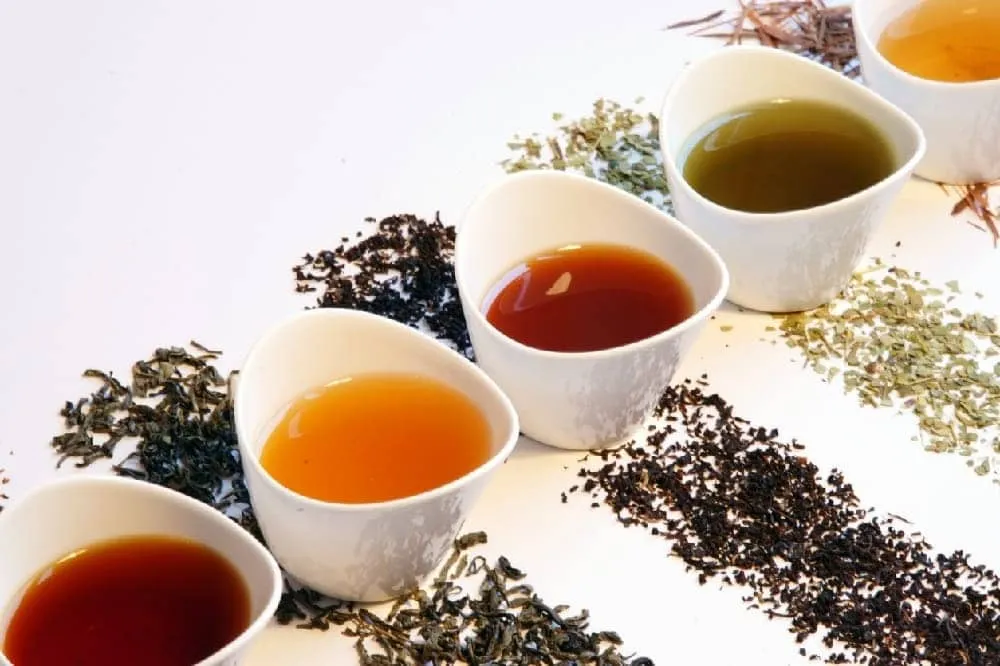When it comes to Chinese tea, there’s a whole world to explore beyond just “green” or “black.” Let’s dive into the different types of tea and what makes each one special.

Tea by Color and Processing Method
Green Tea: The Fresh and Natural Choice

Green tea is unfermented, keeping its natural color and fresh taste. Some popular ones include West Lake Longjing (西湖龙井), known for its smooth and sweet flavor, and Emei Xueya (峨眉雪芽), which offers a delicate aroma.
White Tea: The Gentle and Subtle Brew

White tea is slightly fermented, mainly processed through withering and drying. It retains a fresh and fragrant aroma. Baihao Yinzhen (白毫银针) is a classic example, with its light and sweet taste.
Yellow Tea: The Rare and Unique Find

Yellow tea is lightly fermented and goes through a special “smothering yellowing” process. Mengding Huangya (蒙顶黄芽) is a standout, offering a mellow and sweet flavor.
Oolong Tea: The Complex and Varied Experience

Oolong tea is semi-fermented and comes in many varieties. Famous ones include Wuyi Rock Tea (武夷岩茶), known for its rich and robust flavor, and Anxi Tieguanyin (安溪铁观音), which is floral and smooth.
Black Tea: The Sweet and Aromatic Delight

Black tea is fully fermented, resulting in a sweet tea with a honey aroma. Dian Hong Gongfu (滇红工夫) from Yunnan is a must-try, with its rich and malty taste.
Dark Tea: The Aged and Deep Flavor

Dark tea, including Pu-erh Tea (普洱茶), is post-fermented and often aged, offering a deep and complex flavor. Naka Tea (那卡茶) and Bangwei Tea (邦崴茶) are popular choices.
Tea by Leaf Type
- Large-leaf Varieties: Like the Yunnan Large-leaf variety.
- Medium-leaf Varieties: Found in teas like Wenjun Green Tea (文君绿茶).
- Small-leaf Varieties: Common in the Jiangnan Tea Region.
Tea by Tree Type
- Arbor Type: Tall trees, mostly in Yunnan.
- Small Arbor Type: Between arbor and shrub.
- Shrub Type: Short, mostly in Jiangnan.


Tea by Shape
- Leaf Tea: Like Lu’an Guapian (六安瓜片), known for its unique flat leaves.
- Pearl Tea: Rolled into small pearls.
- Needle Tea: Such as Baihao Yinzhen (白毫银针), with its needle-like appearance.
- Powdered Tea: Matcha, popular during the Song Dynasty.


Tea by Fermentation Degree
- Unfermented: Green Tea
- Slightly Fermented: White Tea
- Lightly Fermented: Yellow Tea
- Semi-Fermented: Oolong Tea
- Fully Fermented: Black Tea
- Post-Fermented: Dark Tea, Pu-erh Tea
Reprocessed Tea
- Flower Tea: Made by processing tea leaves with fragrant flowers.
- Compressed Tea: Like Pu-erh tea cake.
China’s Four Major Tea Regions

Jiangnan Tea Region
Known for small and medium-leaf tea trees, mainly producing green tea. Includes Zhejiang, Jiangsu, and Southern Anhui.
Jiangbei Tea Region
Characterized by soil prone to compaction and low winter temperatures. Includes Henan, Shaanxi, and Shandong.
Southwest Tea Region
An ancient tea region with rich tea tree varieties, mostly arbor-type large-leaf tea trees. Includes Yunnan, Guizhou, and Sichuan.
South China Tea Region
Mainly produces oolong tea and white tea. Includes Fujian, Guangdong, Guangxi, and Hainan.
Other Classifications
- Terrace Tea: From artificially cultivated tea gardens.
- High Mountain Tea: From higher altitudes, offering unique flavors.
- Plain Tea: From plains, not necessarily of lower quality.
Conclusion
Whether you’re a tea newbie or a seasoned sipper, there’s always something new to discover in the world of China tea. Each type has its own personality and story, making Chinese tea one of the most fascinating beverages in the world.





